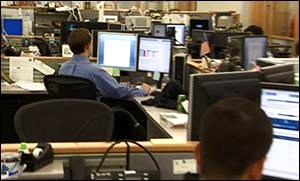By Pam Martens and Russ Martens: June 20, 2017

Photo of the Trading Floor at the New York Fed (Obtained by Wall Street On Parade from a Fed Educational Video)
In 2006 the Federal Reserve’s books were audited by PricewaterhouseCoopers. But beginning in 2007 and for every year thereafter through 2014, the Fed’s books were audited by Deloitte & Touche. That’s a very long eight years that just happen to coincide with the greatest economic upheaval in the U.S. since the Great Depression. (Since 2015, KPMG has issued the annual audited statement of the Fed’s books.)
We’re not suggesting that Deloitte didn’t do its job properly but we are suggesting that the Fed benefited by not having a bunch of different prying eyes looking at its books during those bizarre years when its assets ballooned from $914.8 billion at the end of 2007 to $4.5 trillion in 2014. In just the single year of 2013 the Fed’s assets jumped by a staggering $1 trillion from $2.9 trillion at the end of 2012 to $4 trillion at the end of 2013, according to Deloitte’s audited financial statement of the Fed’s books.
In January of this year, the Government Accountability Office (GAO) released a study indicating that as of October 31, 2016, the government “had disbursed $22.6 billion (60 percent) of the $37.51 billion Troubled Asset Relief Program (TARP) funds” that were directed at helping distressed homeowners as a result of the 2008 Wall Street financial crash and the resulting housing bust. When that report was released, Wall Street On Parade compared it to what the Fed was doing for the banks behind a very dark curtain. We wrote:
“Those paltry billions stand in stark contrast to the $7.8 trillion in near-zero interest loans that the Federal Reserve secretly funneled to just four Wall Street banks from 2007 to 2010. The Fed funneled $2.5 trillion to Citigroup; $2 trillion to Morgan Stanley; $1.9 trillion to Merrill Lynch; and $1.3 trillion to Bank of America. The total amount that the Fed secretly loaned to both U.S. and foreign banks came to $16.1 trillion…
“The American people would still be in the dark about the Federal Reserve’s covert money spigot to the banks except for Senator Bernie Sanders. In 2010, as Congress was debating the Dodd-Frank financial reform legislation, Sanders introduced an amendment that would force the GAO to conduct a one-time audit of the Fed covering its emergency lending programs from December 1, 2007 through July 21, 2010, the date the legislation was signed into law by President Obama. (Because of this abbreviated period of time, the public may still lack full details about Wall Street’s bailout. Sanders got pushback from the White House that prevented him from pushing for a stronger amendment.)
“When the one-time audit of the Fed was released by the GAO in 2011, Sanders said in a statement: ‘This is a clear case of socialism for the rich and rugged, you’re-on-your-own individualism for everyone else.’ ”
Washington would like the American people to believe that the 2008 Wall Street crash is nothing more than a distant memory; that the markets have healed, the economy has recovered, and all is back to normal. There’s just that one pesky detail that strongly suggests nothing is back to normal. The Fed’s balance sheet is still stuck at a whopping $4.5 trillion.
The Fed has been talking about how it’s going to normalize its balance sheet for years. Nothing has happened. Last week, the Fed actually released a hypothetical plan about how it might scale back its reinvestment of maturing principal in its Treasury, agency and mortgage-backed securities portfolio in order to shrink its balance sheet. But here’s the funny thing again: it provided no concrete time frame for this “normalization” process. It said the following on its timing:
“The FOMC [Federal Open Market Committee] intends to reduce the Federal Reserve’s securities holdings in a gradual and predictable manner primarily by ceasing to reinvest repayments of principal on securities held in the System Open Market Account (SOMA) portfolio. The Committee anticipates that it will not cease or commence phasing out reinvestments until normalization of the federal funds rate is well under way. The timing of this step will depend on how economic and financial conditions and the economic outlook evolve.”
The worst of the Wall Street crash occurred in 2008 and 2009. It’s now June of 2017 and the Fed’s balance sheet seems stuck at $4.5 trillion as the stock market sets record highs and the holdings of derivatives by the Wall Street mega banks remain astronomical. The public needs considerably more daylight on the Fed’s books and operations in order to understand if its monetary policy role has seriously mutated.

